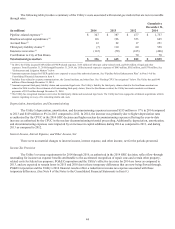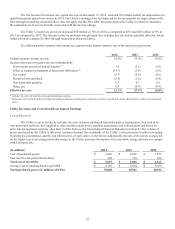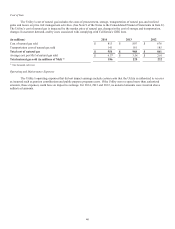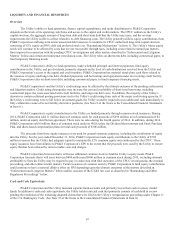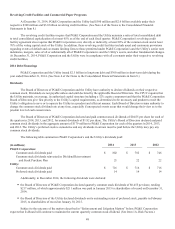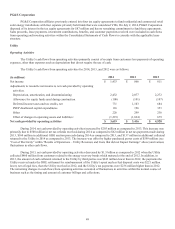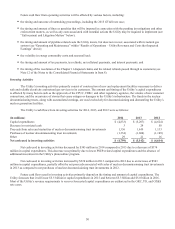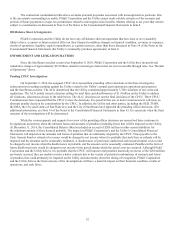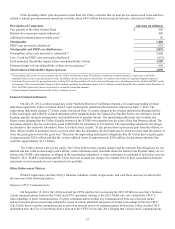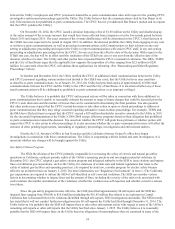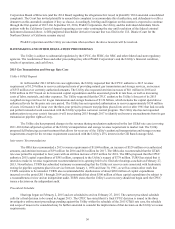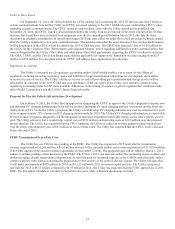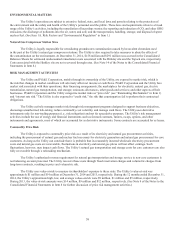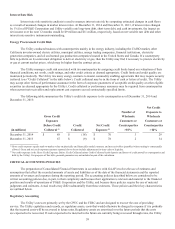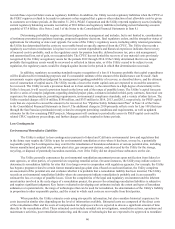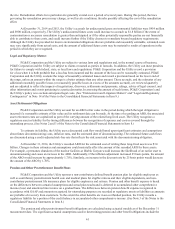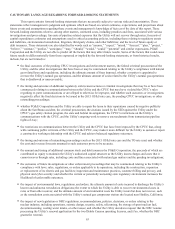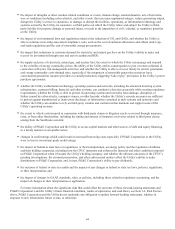PG&E 2014 Annual Report Download - page 62
Download and view the complete annual report
Please find page 62 of the 2014 PG&E annual report below. You can navigate through the pages in the report by either clicking on the pages listed below, or by using the keyword search tool below to find specific information within the annual report.54
between the Utility’s employees and CPUC personnel violated the ex parte communication rules with respect to the pending CPUC
investigative enforcement proceedings against the Utility. The Utility believes that the communications cited by San Bruno in its
July 2014 motion are not prohibited ex parte communications. The CPUC has not yet addressed San Bruno’s motion and its request
that the CPUC penalize the Utility.)
On November 20, 2014, the CPUC issued a decision imposing a fine of $1.05 million on the Utility and disallowing up
to the entire amount of the revenue increase that would have been collected from ratepayers over the five-month period between
March 2015 and August 2015. The exact amount of the revenue disallowance will be determined in the CPUC’s final decision in
the GT&S rate case expected to be issued in August 2015. In addition, the decision prohibits the Utility from engaging in any oral
or written ex parte communications, as well as procedural communications, with Commissioners or their advisors in any rate-
setting or adjudicatory proceeding and requires the Utility to report communications with senior CPUC staff, in any rate-setting
proceeding or adjudicatory proceeding before the CPUC, for one year from the effective date of the decision. With respect to the
GT&S rate case, the ban will be in effect until the resolution of the GT&S rate case or one year from the effective date of the
decision, whichever is later. The Utility and other parties have requested that the CPUC reconsider its decision. The ORA, TURN,
and the City of San Bruno argue that the applicable law supports the imposition of a fine ranging from $2.5 million to $250
million. It is uncertain when the CPUC will address these applications for rehearing. (See “Ratemaking and Other Regulatory
Proceedings” below.)
In October and December 2014, the Utility notified the CPUC of additional email communications between the Utility
and CPUC personnel regarding various matters (not limited to the GT&S rate case), that the Utility believes may constitute
or describe ex parte communications. As of January 30, 2015, the Utility had provided copies of approximately 65,000 email
communications between the CPUC and the Utility to the CPUC and the City of San Bruno. It is uncertain whether any of these
email communications will be challenged as prohibited ex parte communications or as improper or illegal.
The Utility believes it is probable that CPUC enforcement actions will be taken in connection with these additional ex
parte communications but is unable to reasonably estimate the amount or range of future charges that could be incurred given the
CPUC’s wide discretion and the number of factors that can be considered in determining the final penalties. It is also possible
that other parties may request that the CPUC rescind decisions or take other action in open or closed proceedings to address ex
parte communications that they may allege occurred regarding substantive issues in those proceedings. For example, TURN and
the ORA have filed petitions to request that the CPUC rescind a $29 million shareholder incentive awarded to the Utility in 2010
for the successful implementation of the Utility’s 2006-2008 energy efficiency programs based on their allegation that prohibited
ex parte communications tainted the decision. It is uncertain whether the CPUC will grant these petitions or whether parties will
request the CPUC to take action in other proceedings. It is also uncertain whether the ex parte communication issues will affect the
outcome of other pending legal matters, ratemaking or regulatory proceedings, investigations and enforcement matters.
Finally, the U.S. Attorney’s Office in San Francisco and the California Attorney General’s office have begun
investigations in connection with these communications. The Utility is cooperating with the federal and state investigators. It is
uncertain whether any charges will be brought against the Utility.
Gas Safety Citation Program
The SED, the division of the CPUC primarily responsible for overseeing the safety of electric and natural gas utility
operations in California, conducts periodic audits of the Utility’s operating practices and investigates potential violations. In
December 2011, the CPUC adopted a gas safety citation program and delegated authority to the SED to issue citations and impose
fines on California gas corporations, such as the Utility, for violations of certain state and federal regulations that relate to the
safety of natural gas facilities and operating practices. (As required by state law, a similar program for electric safety became
effective on an interim basis on January 1, 2015. For more information, see “Regulatory Environment” in Item 1.) The California
gas corporations are required to inform the SED of self-identified or self-corrected violations. The SED can consider various
factors in determining whether to impose fines and the amount of fines, including the severity of the safety risk associated with
each violation, the number and duration of the violations, whether the violation was self-reported, and whether corrective actions
were taken.
Since the gas safety program became effective, the Utility has filed approximately 84 self-reports and the SED has
imposed fines ranging from $50,000 to $16.8 million (including the $10.85 million fine related to an explosion in Carmel,
California that is discussed below) for violations identified through self-reports, SED investigations and audits. The SED recently
has stated that it will not conduct further investigations into 65 self-reports the Utility had filed through December 31, 2014. The
Utility believes it is probable that the SED will impose fines or take other enforcement action with respect to some of the Utility’s
remaining self-reports or other self-reports that the Utility has filed since January 1, 2015. The Utility believes it is reasonably
possible that the SED will impose fines on the Utility based on allegations of noncompliance that are contained in some of the


